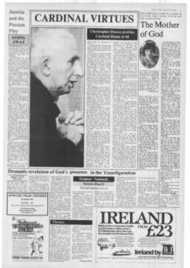Page 3, 25th February 1983
Page 3

Report an error
Noticed an error on this page?If you've noticed an error in this article please click here to report it.
Tags
Share
Related articles
New Education Body
Westminster Sort Out Financial Chaos But Vast Debt Remains
Westminster Is First Diocese To Reveal Financial Plans
Cardinal Hume's Appeal Helped To Cut Deficit
Scheme To Bring 'lost Sheep' Back To The Fold
Pastoral concerns fighting through bureaucratic jungle
The bishops of Westminster have issued a justification of their schools policy. Here
David Browne assesses its effects.
THE WESTMINSTER Diocese has taken an unusual step in the direction of ecclesiastical democracy and accountability by the publication last week of a detailed statement on school reorganisation. — The statement, in the name of Cardinal Hume and Bishops of Westminster, sets out the background to a decision taken last November on the future of Catholic secondary schooling in part of central London. And it spells out the guiding principles and factors taken into account in devising what has turned out to be a contentious plan for seven of the diocese's schools.
Although planning for reorganisation has been going on over the whole country, in the wake of drastically falling numbers of school-age children, no other diocese has been so forthcoming about the ideas and philosophy behind their plans. And while talks have been going on in Westminster for three years at least, it is only at a very advanced stage of planning that the diocesan schools committee has deemed it wise to explain what underlies their decisions.
The writers of the bishops' statement do not say why it was published in February when it refers to a decision taken last November in the course of a process that began in 1979.
They do state the purpose of the statement: to calm fears and set aside
misunderstandings, because the process is entering a particularly crucial phase. "It is hoped that the publication of this statement may help lo clarify the issues and allay anxieties, so that the next stage in the procedure, namely the statutory negotiations and discussions with Governing boards and with parents, staff and members of the public associated with the schools, may go forward smoothly" says the statement.
But many of the anxieties and misunderstandings arise precisely from the previous lack of information available to those people from the diocese's education chiefs, as has been noted by this newspaper in reporting reactions to the plans as they emerged.
This document, or something like it, was needed at the outset of this round of reorganisation.
The "secular" local authorities know this and have spent much money and effort in 'selling' their plans to the people involved. In contrast London Catholics have had the spectacle, for example, of diocesan officials absenting themselves from at least one key public meeting to clarify the issues for staff and parents of schools involved in a form of reorganisation they recognised as closure.
And until very recently, officials in the central education office of the Westminster diocese have refused to answer questions from the Catholic press when we have sought clarification in the knowledge of the kind of anxieties the bishops now acknowledge.
The Catholic press could have been an effective forum in which to promote the central issues which sometimes over-ride the legitimate concerns of individual schools — the kind of issues outlined in this new statement.
The document summarises the stages that the diocese has been through so far and the procedures still to come. The specific case it deals with is that of the Catholic secondary schools in Division One of the ILEA area.
The bishops admit that the decision of last November is very close indeed to the original plan that they first rejected. They show also that they were pressured by the authority to speed up their decisionmaking.
But it is the principles outlined that make this statement a valuable study of issues that are much wider that a part of the Westminster diocese.
The seven schools referred to in the statement have an annual intake of about 850 pupils. But indications are that this will fall to only 630 by 1986.
These reductions and worse are reflected in the rest of the country. So changes have to be made in the schools. The bishops state their overall purpose in this way: "The aim is to have a group of schools which will develop relatively easily from the present system, and which will ensure a good Catholic education for the children of the area, from every background and of all abilities.
"There should be good facilities for the education of those over the age of 16 years. There should be, as far as possible, scope for reasonable choice for parents in selecting the type of school they wish their children to attend".
Among the guiding principles applied by the bishops are: • Catholic schools should be communities of faith in which the Christian development of the individual pupil is paramount.
• Catholic schools have a particular responsibility towards the less advantaged, including pupils from broken homes, single parent families, minority ethnic backgrounds and those from families where Catholic faith and practice are weak.
• Comprehensive schools serve a whole spectrum of abilities and gifts and must provide a balanced range of courses along with a system of values essential to the growth of individual pupils.
• The outright closure of any school should be avoided if at all possible. Where numbers of applicants are falling drastically, progress towards amalgamation with another school is im rortant. • Split-site working is to be avoided for pupils below the age of 16. Older pupils may benefit from a wider range of courses than one school can offer.
And the statement points out two significant future trends: the proportion of children from different ethnic and coltural backgrounds will grow and there will be more children from one-parent families or broken homes coming into the secondary schools.
The ideal to he worked for is a family of schools, developing as a single educational enterprise, sharing common Catholic values, drawing on the particular strengths of each school, and serving the whole community.
These are worthy sentiments indeed, and the exercise of spelling out principles behind the policies is welcomed. There is, however, one sentence which lets them down: "There is no intrinsic merit or justice in ensuring that the disturbance inherent in reorganisation affects everyone equally."
This is the classic excuse of the bureaucrat which betrays a decision that could have been made for administrative expediency in the face of the pressing need to tailor the number of school places realistically to the number of school children available to fill them, whatever the pastoral needs might be.
blog comments powered by Disqus











